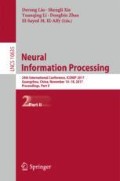Abstract
Words in some natural languages can have a composite structure. Elements of this structure include the root (that could also be composite), prefixes and suffixes with which various nuances and relations to other words can be expressed. Thus, in order to build a proper word representation one must take into account its internal structure. From a corpus of texts we extract a set of frequent subwords and from the latter set we select patterns, i.e. subwords which encapsulate information on character n-gram regularities. The selection is made using the pattern-based Conditional Random Field model [19, 23] with \(l_1\) regularization. Further, for every word we construct a new sequence over an alphabet of patterns. The new alphabet’s symbols confine a local statistical context stronger than the characters, therefore they allow better representations in \({\mathbb {R}}^n\) and are better building blocks for word representation. In the task of subword-aware language modeling, pattern-based models outperform character-based analogues by 2–20 perplexity points. Also, a recurrent neural network in which a word is represented as a sum of embeddings of its patterns is on par with a competitive and significantly more sophisticated character-based convolutional architecture.
Access this chapter
Tax calculation will be finalised at checkout
Purchases are for personal use only
Notes
- 1.
Word length in characters and in patterns is the same.
- 2.
Around 1.2x speedup on NVIDIA Titan X (Pascal).
References
Abadi, M., Agarwal, A., Barham, P., Brevdo, E., Chen, Z., Citro, C., Corrado, G.S., Davis, A., Dean, J., Devin, M., et al.: Tensorflow: Large-scale machine learning on heterogeneous distributed systems (2016). arXiv preprint: arXiv:1603.04467
Bojanowski, P., Grave, E., Joulin, A., Mikolov, T.: Enriching word vectors with subword information (2016). arXiv preprint: arXiv:1607.04606
Botha, J., Blunsom, P.: Compositional morphology for word representations and language modelling. In: Proceedings of the 31st International Conference on Machine Learning (ICML 2014), pp. 1899–1907 (2014)
Chomsky, N.: Three models for the description of language. IRE Trans. Inf. Theor. 2(3), 113–124 (1956)
Gal, Y., Ghahramani, Z.: A theoretically grounded application of dropout in recurrent neural networks. In: Advances in Neural Information Processing Systems, pp. 1019–1027 (2016)
Graves, A.: Generating sequences with recurrent neural networks (2013). arXiv preprint: arXiv:1308.0850
Hardt, M., Ma, T.: Identity matters in deep learning (2016). arXiv preprint: arXiv:1611.04231
Hochreiter, S., Schmidhuber, J.: Long short-term memory. Neural Comput. 9(8), 1735–1780 (1997)
Kim, Y., Jernite, Y., Sontag, D., Rush, A.M.: Character-aware neural language models. In: Proceedings of the Thirtieth AAAI Conference on Artificial Intelligence, pp. 2741–2749. AAAI Press (2016)
Lankinen, M., Heikinheimo, H., Takala, P., Raiko, T., Karhunen, J.: A character-word compositional neural language model for finnish (2016). arXiv preprint: arXiv:1612.03266
Ling, W., Dyer, C., Black, A.W., Trancoso, I., Fermandez, R., Amir, S., Marujo, L., Luis, T.: Finding function in form: compositional character models for open vocabulary word representation. In: Proceedings of the 2015 Conference on Empirical Methods in Natural Language Processing, Lisbon, Portugal, pp. 1520–1530. Association for Computational Linguistics, September 2015
Marcus, M.P., Marcinkiewicz, M.A., Santorini, B.: Building a large annotated corpus of English: the penn treebank. Comput. Linguist. 19(2), 313–330 (1993)
Merity, S., Xiong, C., Bradbury, J., Socher, R.: Pointer sentinel mixture models. In: Proceedings of ICLR 2017 (2017)
Mikolov, T., Karafiát, M., Burget, L., Cernockỳ, J., Khudanpur, S.: Recurrent neural network based language model. In: Interspeech, vol. 2, p. 3 (2010)
Mikolov, T., Sutskever, I., Deoras, A., Le, H.S., Kombrink, S., Cernocky, J.: Subword language modeling with neural networks (2012). Preprint (http://www.fit.vutbr.cz/imikolov/rnnlm/char.pdf)
Shannon, C.E., Weaver, W.: A mathematical theory of communication (1963)
Sperr, H., Niehues, J., Waibel, A.: Letter n-gram-based input encoding for continuous space language models. In: Proceedings of the Workshop on Continuous Vector Space Models and their Compositionality, pp. 30–39 (2013)
Srivastava, R.K., Greff, K., Schmidhuber, J.: Training very deep networks. In: Advances in Neural Information Processing Systems, pp. 2377–2385 (2015)
Takhanov, R., Kolmogorov, V.: Inference algorithms for pattern-based CRFs on sequence data. In: ICML, vol. 3, pp. 145–153 (2013)
Verwimp, L., Pelemans, J., Wambacq, P., et al.: Character-word LSTM language models. In: Proceedings of EACL 2017 (2017)
Werbos, P.J.: Backpropagation through time: what it does and how to do it. Proc. IEEE 78(10), 1550–1560 (1990)
Wieting, J., Bansal, M., Gimpel, K., Livescu, K.: Charagram: embedding words and sentences via character n-grams. In: Proceedings of the 2016 Conference on Empirical Methods in Natural Language Processing, EMNLP 2016, Austin, Texas, USA, pp. 1504–1515, 1–4 November 2016
Ye, N., Lee, W.S., Chieu, H.L., Wu, D.: Conditional random fields with high-order features for sequence labeling. In: Advances in Neural Information Processing Systems, pp. 2196–2204 (2009)
Zaremba, W., Sutskever, I., Vinyals, O.: Recurrent neural network regularization (2014). arXiv preprint: arXiv:1409.2329
Zilly, J.G., Srivastava, R.K., Koutník, J., Schmidhuber, J.: Recurrent highway networks (2016). arXiv preprint: arXiv:1607.03474
Zoph, B., Le, Q.V.: Neural architecture search with reinforcement learning. In: Proceedings of ICLR 2017 (2017)
Acknowledgments
We gratefully acknowledge the support of NVIDIA Corporation with the donation of the Titan X Pascal GPU used for this research.
Author information
Authors and Affiliations
Corresponding author
Editor information
Editors and Affiliations
Rights and permissions
Copyright information
© 2017 Springer International Publishing AG
About this paper
Cite this paper
Takhanov, R., Assylbekov, Z. (2017). Patterns Versus Characters in Subword-Aware Neural Language Modeling. In: Liu, D., Xie, S., Li, Y., Zhao, D., El-Alfy, ES. (eds) Neural Information Processing. ICONIP 2017. Lecture Notes in Computer Science(), vol 10635. Springer, Cham. https://doi.org/10.1007/978-3-319-70096-0_17
Download citation
DOI: https://doi.org/10.1007/978-3-319-70096-0_17
Published:
Publisher Name: Springer, Cham
Print ISBN: 978-3-319-70095-3
Online ISBN: 978-3-319-70096-0
eBook Packages: Computer ScienceComputer Science (R0)

